CUC100 Assessment 2: Core Readings Summary & Relevance Analysis
VerifiedAdded on 2023/06/12
|6
|1454
|82
Annotated Bibliography
AI Summary
This annotated bibliography provides summaries and commentaries on three core readings related to sustainability. The first reading defines sustainability through the lens of interconnected systems and the 'triple bottom line' (environment, economy, and equity), highlighting challenges like population growth and species extinction. The second reading discusses a sustainability triad method for educators to teach sustainability concepts, using case studies to assess the congruence or conflict between environmental, social, and economic dimensions. The third reading examines the evolving perception of mining in Western Australia, from environmental disruption to sustainable practices, noting the economic benefits and remaining environmental vulnerabilities. Each summary identifies key ideas and their potential application in developing an essay on sustainability. The document concludes with a reference list of the core readings.
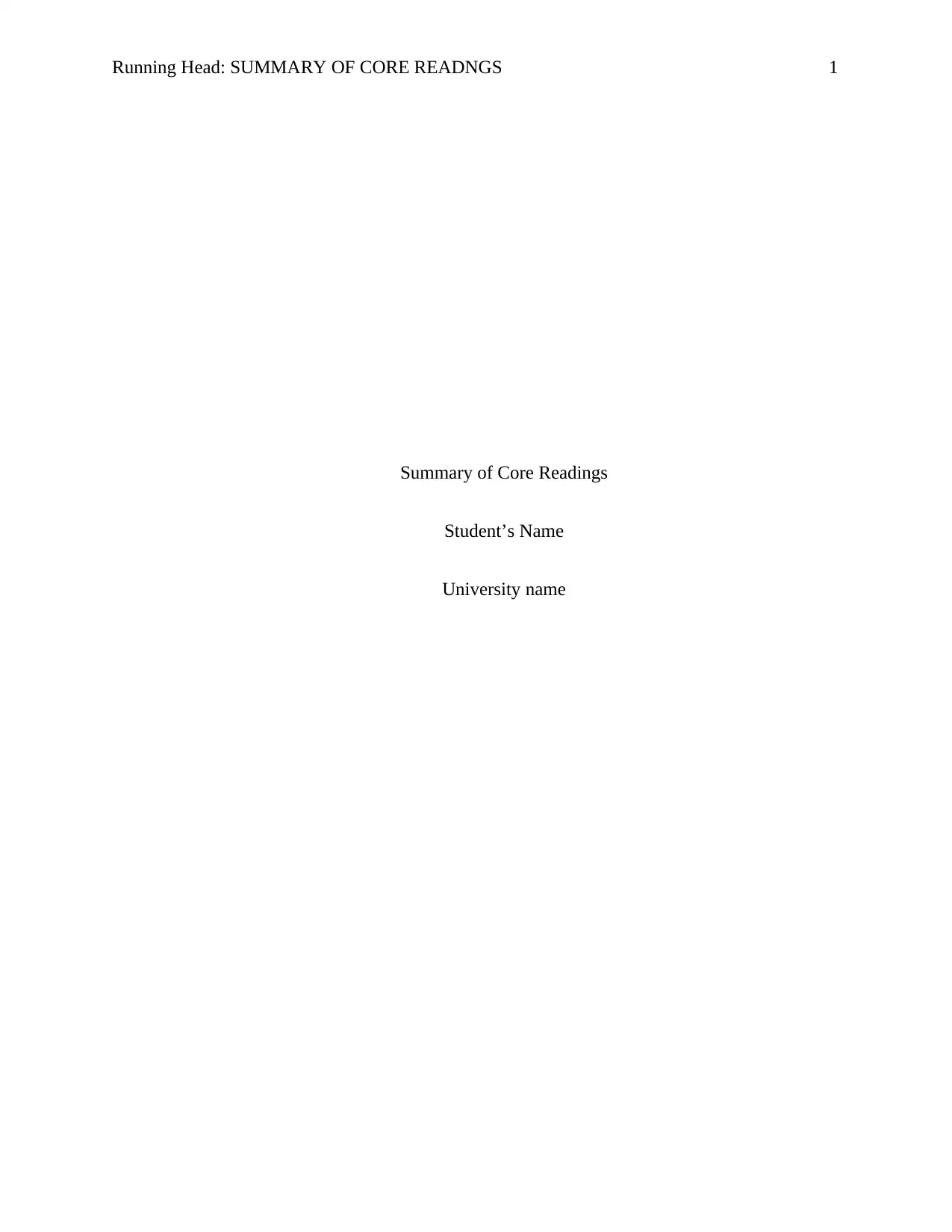
Running Head: SUMMARY OF CORE READNGS 1
Summary of Core Readings
Student’s Name
University name
Summary of Core Readings
Student’s Name
University name
Paraphrase This Document
Need a fresh take? Get an instant paraphrase of this document with our AI Paraphraser
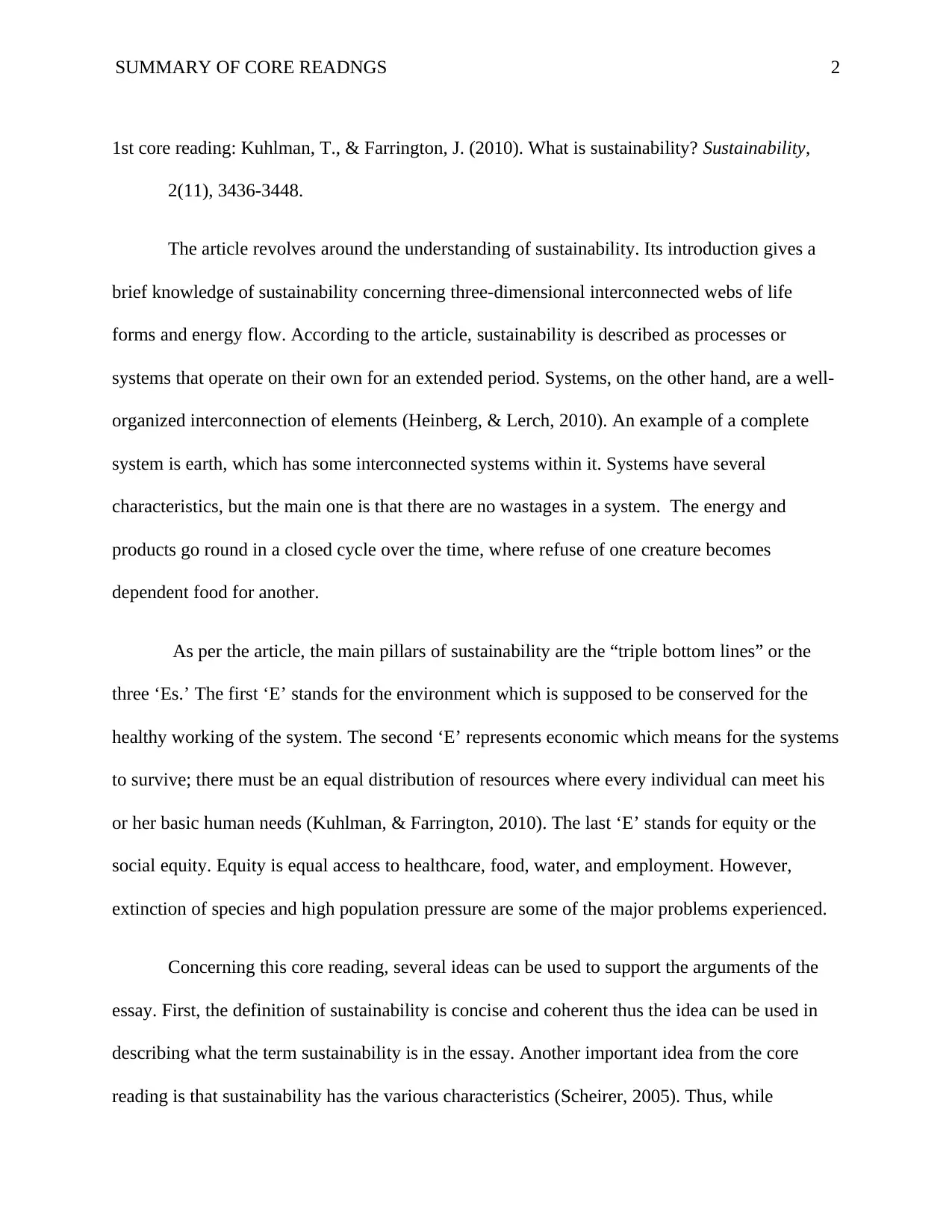
SUMMARY OF CORE READNGS 2
1st core reading: Kuhlman, T., & Farrington, J. (2010). What is sustainability? Sustainability,
2(11), 3436-3448.
The article revolves around the understanding of sustainability. Its introduction gives a
brief knowledge of sustainability concerning three-dimensional interconnected webs of life
forms and energy flow. According to the article, sustainability is described as processes or
systems that operate on their own for an extended period. Systems, on the other hand, are a well-
organized interconnection of elements (Heinberg, & Lerch, 2010). An example of a complete
system is earth, which has some interconnected systems within it. Systems have several
characteristics, but the main one is that there are no wastages in a system. The energy and
products go round in a closed cycle over the time, where refuse of one creature becomes
dependent food for another.
As per the article, the main pillars of sustainability are the “triple bottom lines” or the
three ‘Es.’ The first ‘E’ stands for the environment which is supposed to be conserved for the
healthy working of the system. The second ‘E’ represents economic which means for the systems
to survive; there must be an equal distribution of resources where every individual can meet his
or her basic human needs (Kuhlman, & Farrington, 2010). The last ‘E’ stands for equity or the
social equity. Equity is equal access to healthcare, food, water, and employment. However,
extinction of species and high population pressure are some of the major problems experienced.
Concerning this core reading, several ideas can be used to support the arguments of the
essay. First, the definition of sustainability is concise and coherent thus the idea can be used in
describing what the term sustainability is in the essay. Another important idea from the core
reading is that sustainability has the various characteristics (Scheirer, 2005). Thus, while
1st core reading: Kuhlman, T., & Farrington, J. (2010). What is sustainability? Sustainability,
2(11), 3436-3448.
The article revolves around the understanding of sustainability. Its introduction gives a
brief knowledge of sustainability concerning three-dimensional interconnected webs of life
forms and energy flow. According to the article, sustainability is described as processes or
systems that operate on their own for an extended period. Systems, on the other hand, are a well-
organized interconnection of elements (Heinberg, & Lerch, 2010). An example of a complete
system is earth, which has some interconnected systems within it. Systems have several
characteristics, but the main one is that there are no wastages in a system. The energy and
products go round in a closed cycle over the time, where refuse of one creature becomes
dependent food for another.
As per the article, the main pillars of sustainability are the “triple bottom lines” or the
three ‘Es.’ The first ‘E’ stands for the environment which is supposed to be conserved for the
healthy working of the system. The second ‘E’ represents economic which means for the systems
to survive; there must be an equal distribution of resources where every individual can meet his
or her basic human needs (Kuhlman, & Farrington, 2010). The last ‘E’ stands for equity or the
social equity. Equity is equal access to healthcare, food, water, and employment. However,
extinction of species and high population pressure are some of the major problems experienced.
Concerning this core reading, several ideas can be used to support the arguments of the
essay. First, the definition of sustainability is concise and coherent thus the idea can be used in
describing what the term sustainability is in the essay. Another important idea from the core
reading is that sustainability has the various characteristics (Scheirer, 2005). Thus, while
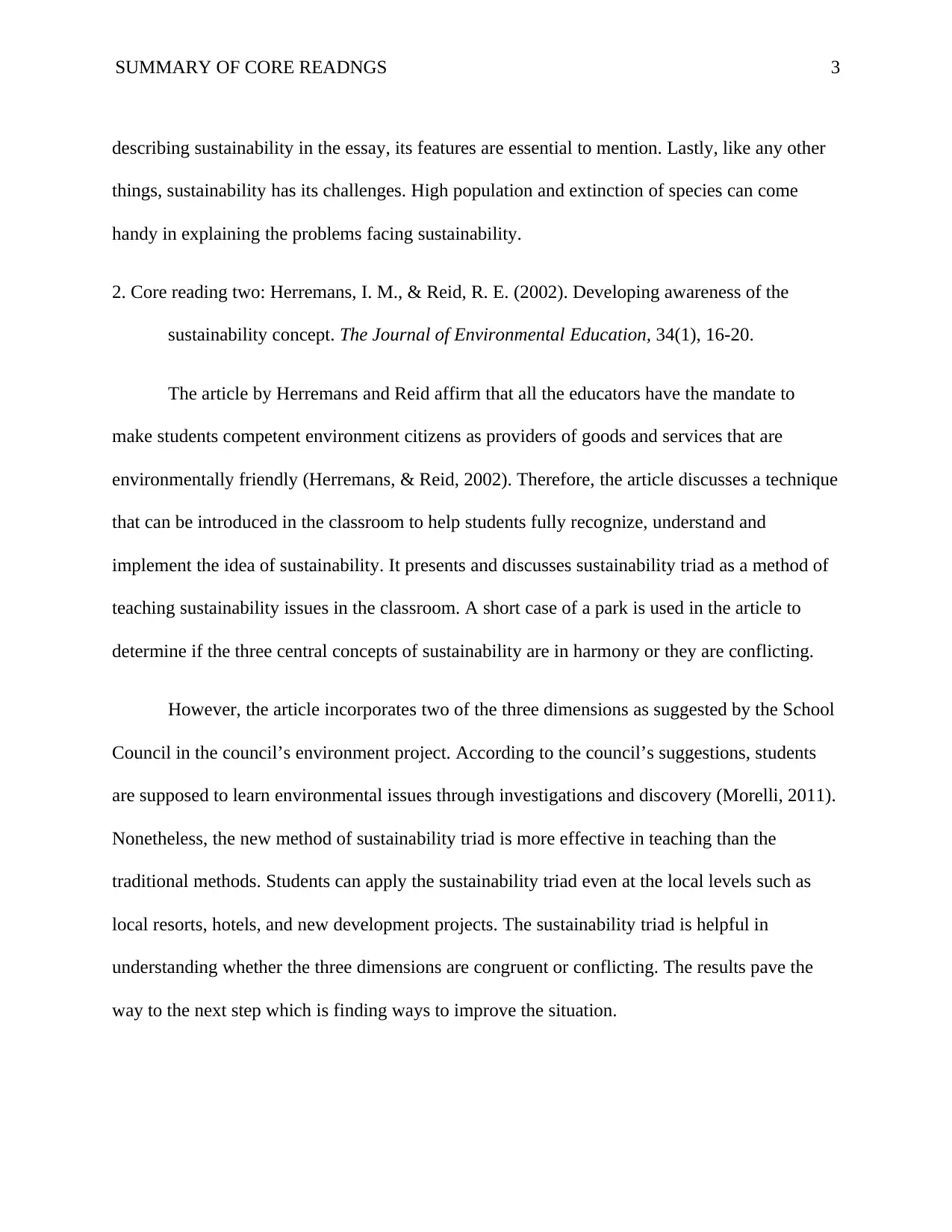
SUMMARY OF CORE READNGS 3
describing sustainability in the essay, its features are essential to mention. Lastly, like any other
things, sustainability has its challenges. High population and extinction of species can come
handy in explaining the problems facing sustainability.
2. Core reading two: Herremans, I. M., & Reid, R. E. (2002). Developing awareness of the
sustainability concept. The Journal of Environmental Education, 34(1), 16-20.
The article by Herremans and Reid affirm that all the educators have the mandate to
make students competent environment citizens as providers of goods and services that are
environmentally friendly (Herremans, & Reid, 2002). Therefore, the article discusses a technique
that can be introduced in the classroom to help students fully recognize, understand and
implement the idea of sustainability. It presents and discusses sustainability triad as a method of
teaching sustainability issues in the classroom. A short case of a park is used in the article to
determine if the three central concepts of sustainability are in harmony or they are conflicting.
However, the article incorporates two of the three dimensions as suggested by the School
Council in the council’s environment project. According to the council’s suggestions, students
are supposed to learn environmental issues through investigations and discovery (Morelli, 2011).
Nonetheless, the new method of sustainability triad is more effective in teaching than the
traditional methods. Students can apply the sustainability triad even at the local levels such as
local resorts, hotels, and new development projects. The sustainability triad is helpful in
understanding whether the three dimensions are congruent or conflicting. The results pave the
way to the next step which is finding ways to improve the situation.
describing sustainability in the essay, its features are essential to mention. Lastly, like any other
things, sustainability has its challenges. High population and extinction of species can come
handy in explaining the problems facing sustainability.
2. Core reading two: Herremans, I. M., & Reid, R. E. (2002). Developing awareness of the
sustainability concept. The Journal of Environmental Education, 34(1), 16-20.
The article by Herremans and Reid affirm that all the educators have the mandate to
make students competent environment citizens as providers of goods and services that are
environmentally friendly (Herremans, & Reid, 2002). Therefore, the article discusses a technique
that can be introduced in the classroom to help students fully recognize, understand and
implement the idea of sustainability. It presents and discusses sustainability triad as a method of
teaching sustainability issues in the classroom. A short case of a park is used in the article to
determine if the three central concepts of sustainability are in harmony or they are conflicting.
However, the article incorporates two of the three dimensions as suggested by the School
Council in the council’s environment project. According to the council’s suggestions, students
are supposed to learn environmental issues through investigations and discovery (Morelli, 2011).
Nonetheless, the new method of sustainability triad is more effective in teaching than the
traditional methods. Students can apply the sustainability triad even at the local levels such as
local resorts, hotels, and new development projects. The sustainability triad is helpful in
understanding whether the three dimensions are congruent or conflicting. The results pave the
way to the next step which is finding ways to improve the situation.
⊘ This is a preview!⊘
Do you want full access?
Subscribe today to unlock all pages.

Trusted by 1+ million students worldwide
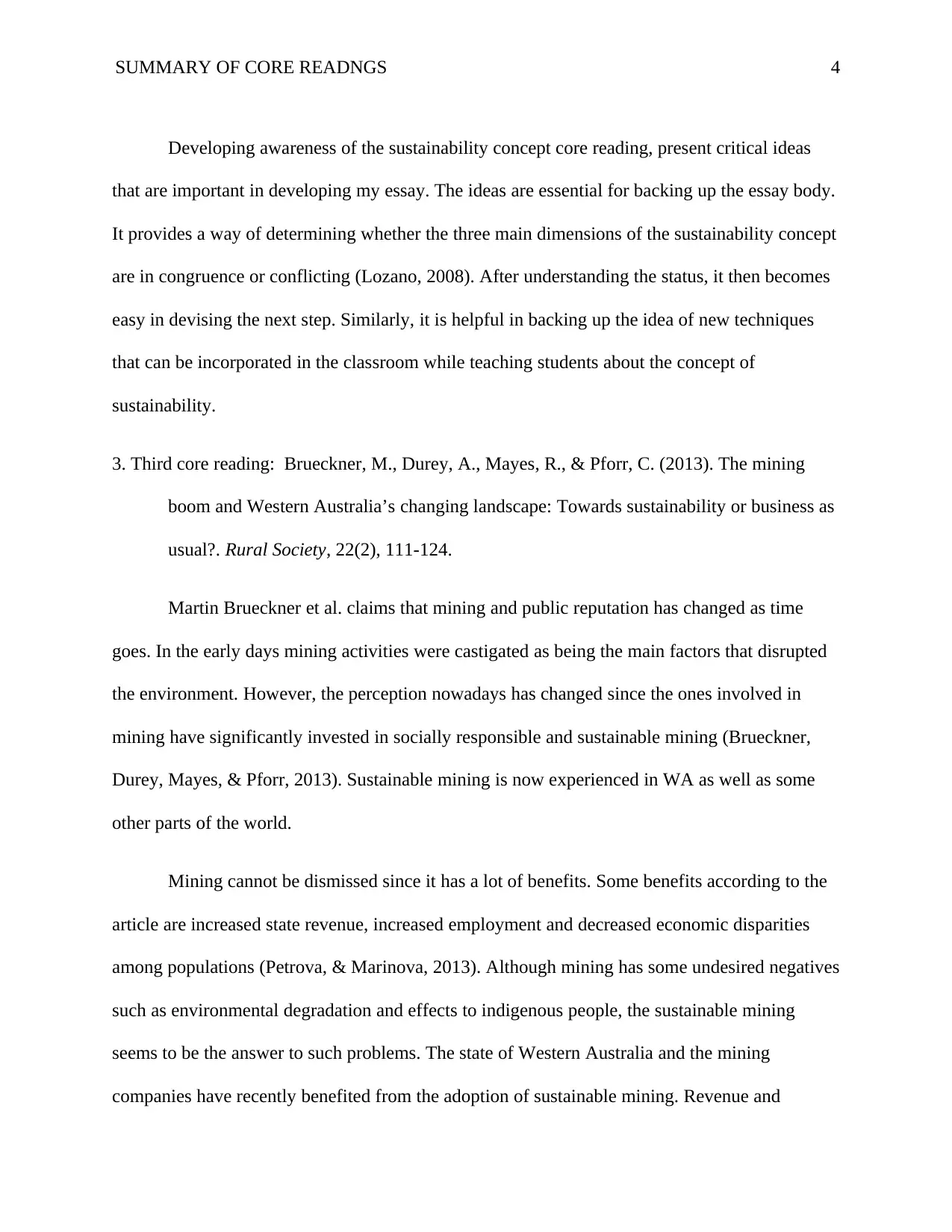
SUMMARY OF CORE READNGS 4
Developing awareness of the sustainability concept core reading, present critical ideas
that are important in developing my essay. The ideas are essential for backing up the essay body.
It provides a way of determining whether the three main dimensions of the sustainability concept
are in congruence or conflicting (Lozano, 2008). After understanding the status, it then becomes
easy in devising the next step. Similarly, it is helpful in backing up the idea of new techniques
that can be incorporated in the classroom while teaching students about the concept of
sustainability.
3. Third core reading: Brueckner, M., Durey, A., Mayes, R., & Pforr, C. (2013). The mining
boom and Western Australia’s changing landscape: Towards sustainability or business as
usual?. Rural Society, 22(2), 111-124.
Martin Brueckner et al. claims that mining and public reputation has changed as time
goes. In the early days mining activities were castigated as being the main factors that disrupted
the environment. However, the perception nowadays has changed since the ones involved in
mining have significantly invested in socially responsible and sustainable mining (Brueckner,
Durey, Mayes, & Pforr, 2013). Sustainable mining is now experienced in WA as well as some
other parts of the world.
Mining cannot be dismissed since it has a lot of benefits. Some benefits according to the
article are increased state revenue, increased employment and decreased economic disparities
among populations (Petrova, & Marinova, 2013). Although mining has some undesired negatives
such as environmental degradation and effects to indigenous people, the sustainable mining
seems to be the answer to such problems. The state of Western Australia and the mining
companies have recently benefited from the adoption of sustainable mining. Revenue and
Developing awareness of the sustainability concept core reading, present critical ideas
that are important in developing my essay. The ideas are essential for backing up the essay body.
It provides a way of determining whether the three main dimensions of the sustainability concept
are in congruence or conflicting (Lozano, 2008). After understanding the status, it then becomes
easy in devising the next step. Similarly, it is helpful in backing up the idea of new techniques
that can be incorporated in the classroom while teaching students about the concept of
sustainability.
3. Third core reading: Brueckner, M., Durey, A., Mayes, R., & Pforr, C. (2013). The mining
boom and Western Australia’s changing landscape: Towards sustainability or business as
usual?. Rural Society, 22(2), 111-124.
Martin Brueckner et al. claims that mining and public reputation has changed as time
goes. In the early days mining activities were castigated as being the main factors that disrupted
the environment. However, the perception nowadays has changed since the ones involved in
mining have significantly invested in socially responsible and sustainable mining (Brueckner,
Durey, Mayes, & Pforr, 2013). Sustainable mining is now experienced in WA as well as some
other parts of the world.
Mining cannot be dismissed since it has a lot of benefits. Some benefits according to the
article are increased state revenue, increased employment and decreased economic disparities
among populations (Petrova, & Marinova, 2013). Although mining has some undesired negatives
such as environmental degradation and effects to indigenous people, the sustainable mining
seems to be the answer to such problems. The state of Western Australia and the mining
companies have recently benefited from the adoption of sustainable mining. Revenue and
Paraphrase This Document
Need a fresh take? Get an instant paraphrase of this document with our AI Paraphraser
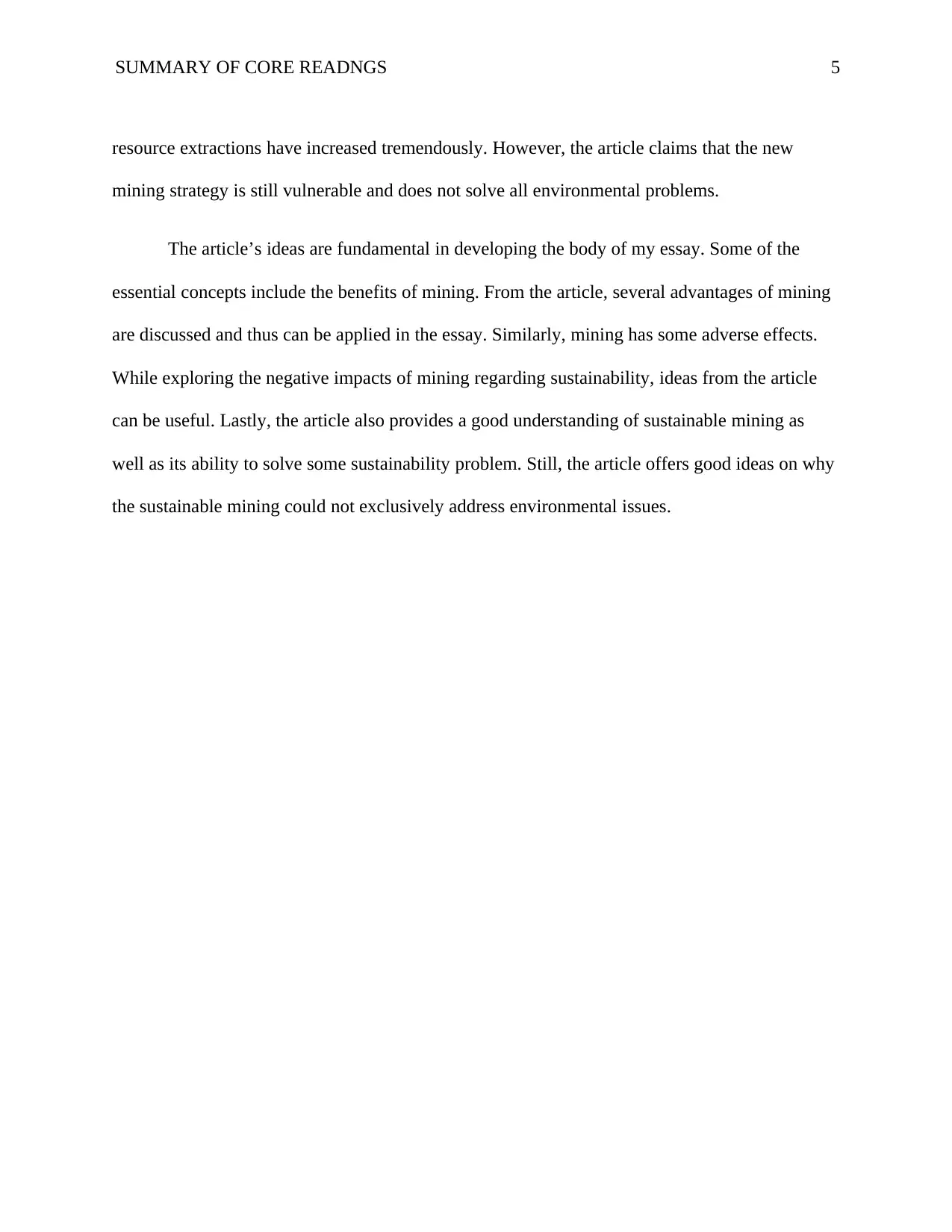
SUMMARY OF CORE READNGS 5
resource extractions have increased tremendously. However, the article claims that the new
mining strategy is still vulnerable and does not solve all environmental problems.
The article’s ideas are fundamental in developing the body of my essay. Some of the
essential concepts include the benefits of mining. From the article, several advantages of mining
are discussed and thus can be applied in the essay. Similarly, mining has some adverse effects.
While exploring the negative impacts of mining regarding sustainability, ideas from the article
can be useful. Lastly, the article also provides a good understanding of sustainable mining as
well as its ability to solve some sustainability problem. Still, the article offers good ideas on why
the sustainable mining could not exclusively address environmental issues.
resource extractions have increased tremendously. However, the article claims that the new
mining strategy is still vulnerable and does not solve all environmental problems.
The article’s ideas are fundamental in developing the body of my essay. Some of the
essential concepts include the benefits of mining. From the article, several advantages of mining
are discussed and thus can be applied in the essay. Similarly, mining has some adverse effects.
While exploring the negative impacts of mining regarding sustainability, ideas from the article
can be useful. Lastly, the article also provides a good understanding of sustainable mining as
well as its ability to solve some sustainability problem. Still, the article offers good ideas on why
the sustainable mining could not exclusively address environmental issues.
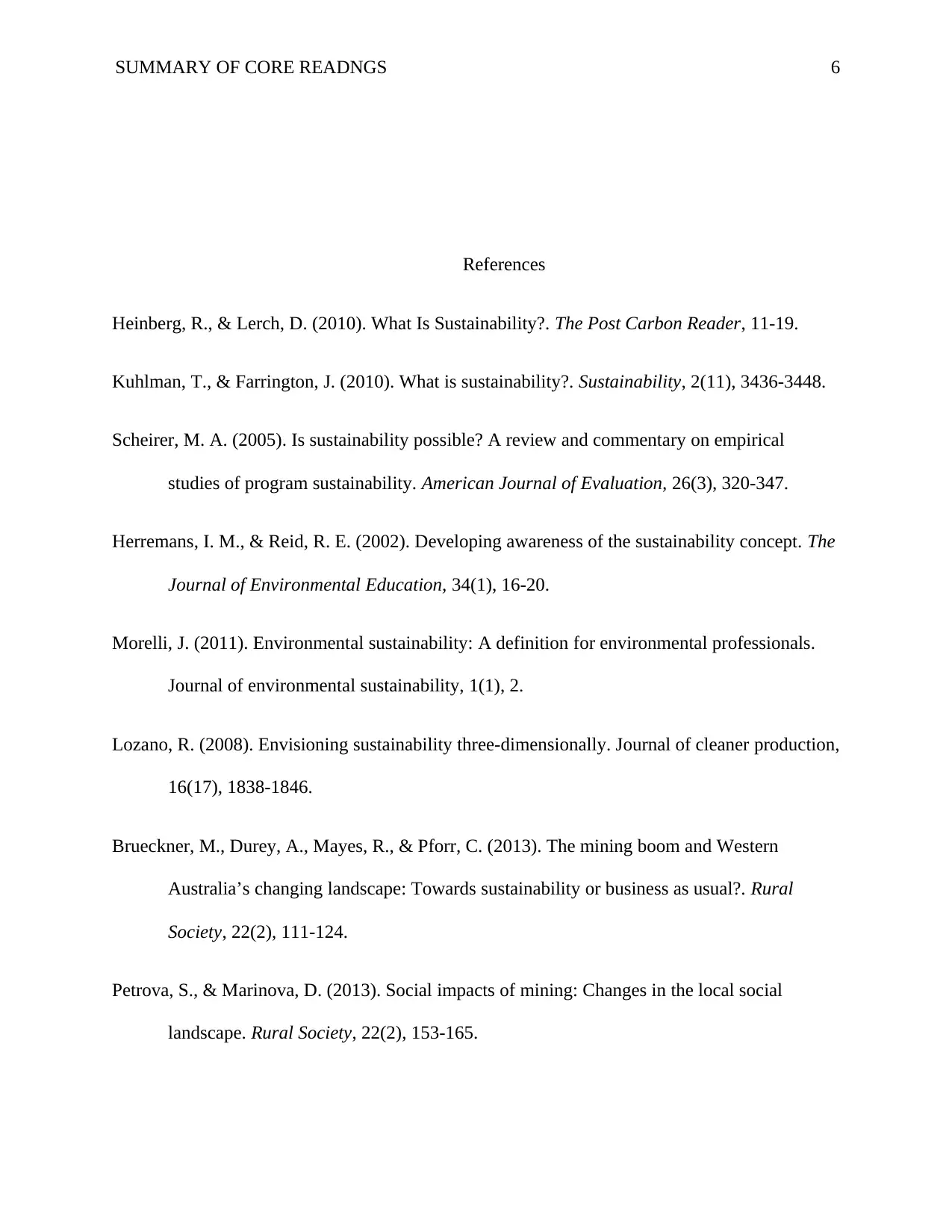
SUMMARY OF CORE READNGS 6
References
Heinberg, R., & Lerch, D. (2010). What Is Sustainability?. The Post Carbon Reader, 11-19.
Kuhlman, T., & Farrington, J. (2010). What is sustainability?. Sustainability, 2(11), 3436-3448.
Scheirer, M. A. (2005). Is sustainability possible? A review and commentary on empirical
studies of program sustainability. American Journal of Evaluation, 26(3), 320-347.
Herremans, I. M., & Reid, R. E. (2002). Developing awareness of the sustainability concept. The
Journal of Environmental Education, 34(1), 16-20.
Morelli, J. (2011). Environmental sustainability: A definition for environmental professionals.
Journal of environmental sustainability, 1(1), 2.
Lozano, R. (2008). Envisioning sustainability three-dimensionally. Journal of cleaner production,
16(17), 1838-1846.
Brueckner, M., Durey, A., Mayes, R., & Pforr, C. (2013). The mining boom and Western
Australia’s changing landscape: Towards sustainability or business as usual?. Rural
Society, 22(2), 111-124.
Petrova, S., & Marinova, D. (2013). Social impacts of mining: Changes in the local social
landscape. Rural Society, 22(2), 153-165.
References
Heinberg, R., & Lerch, D. (2010). What Is Sustainability?. The Post Carbon Reader, 11-19.
Kuhlman, T., & Farrington, J. (2010). What is sustainability?. Sustainability, 2(11), 3436-3448.
Scheirer, M. A. (2005). Is sustainability possible? A review and commentary on empirical
studies of program sustainability. American Journal of Evaluation, 26(3), 320-347.
Herremans, I. M., & Reid, R. E. (2002). Developing awareness of the sustainability concept. The
Journal of Environmental Education, 34(1), 16-20.
Morelli, J. (2011). Environmental sustainability: A definition for environmental professionals.
Journal of environmental sustainability, 1(1), 2.
Lozano, R. (2008). Envisioning sustainability three-dimensionally. Journal of cleaner production,
16(17), 1838-1846.
Brueckner, M., Durey, A., Mayes, R., & Pforr, C. (2013). The mining boom and Western
Australia’s changing landscape: Towards sustainability or business as usual?. Rural
Society, 22(2), 111-124.
Petrova, S., & Marinova, D. (2013). Social impacts of mining: Changes in the local social
landscape. Rural Society, 22(2), 153-165.
⊘ This is a preview!⊘
Do you want full access?
Subscribe today to unlock all pages.

Trusted by 1+ million students worldwide
1 out of 6
Your All-in-One AI-Powered Toolkit for Academic Success.
+13062052269
info@desklib.com
Available 24*7 on WhatsApp / Email
![[object Object]](/_next/static/media/star-bottom.7253800d.svg)
Unlock your academic potential
Copyright © 2020–2025 A2Z Services. All Rights Reserved. Developed and managed by ZUCOL.

